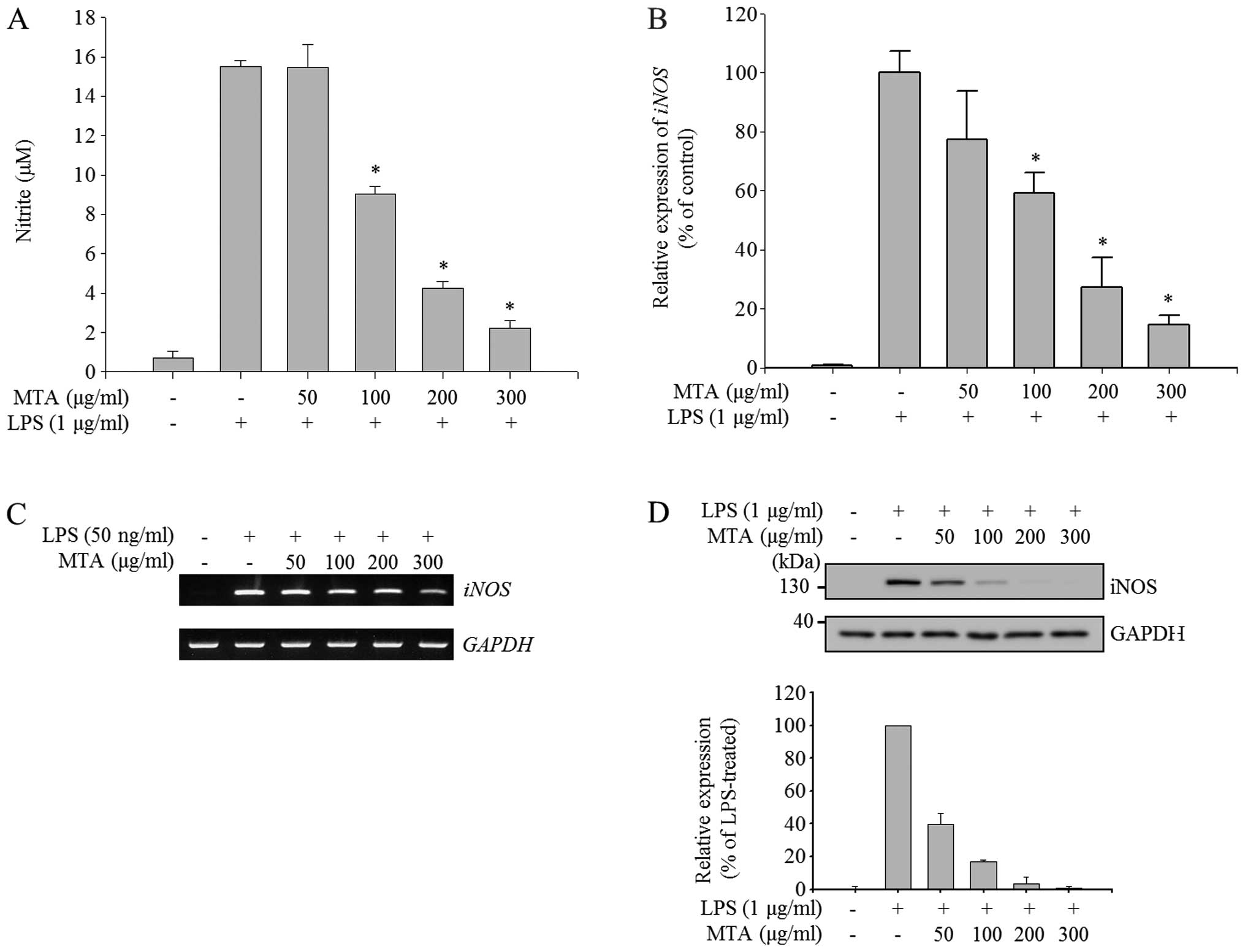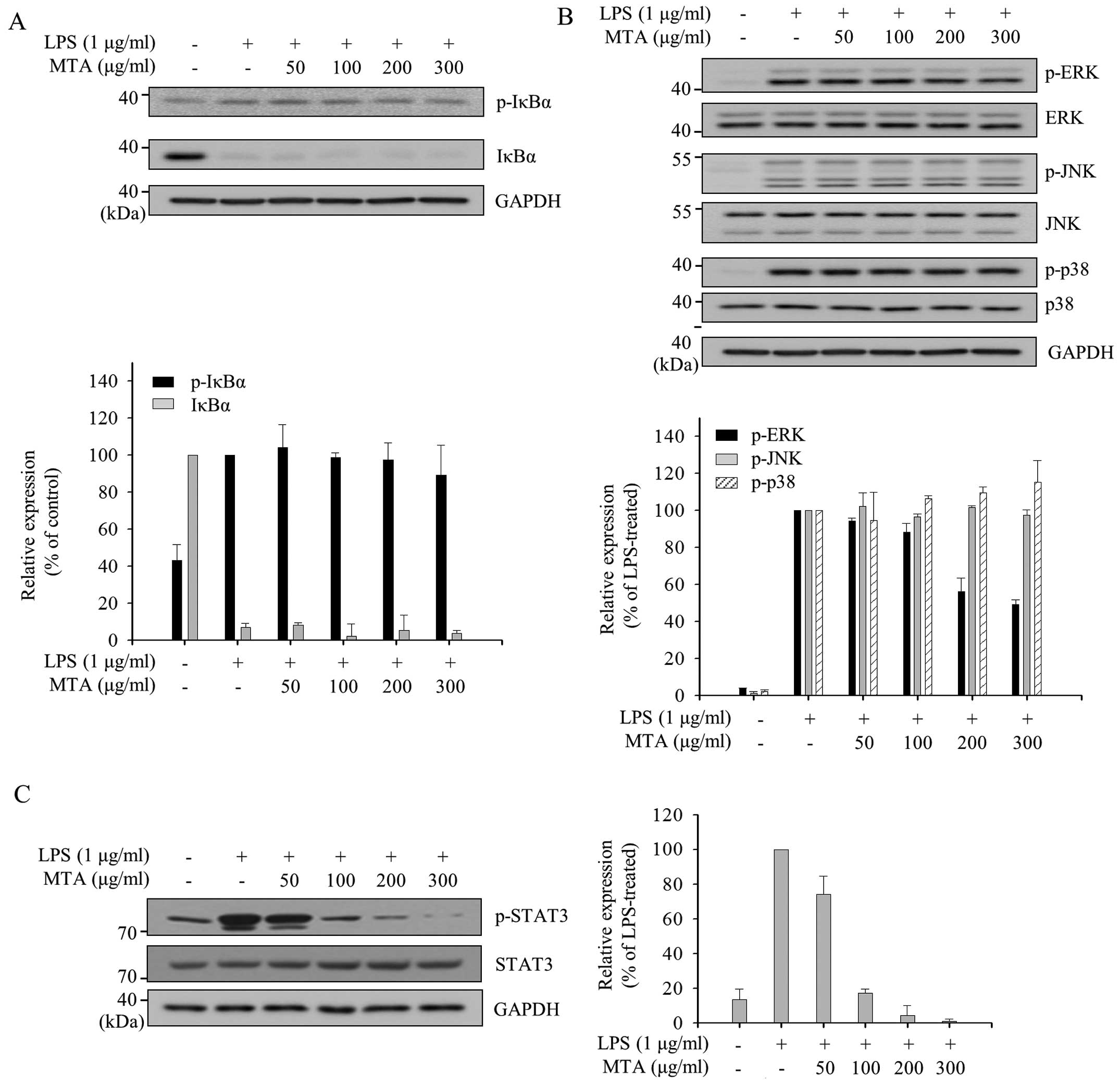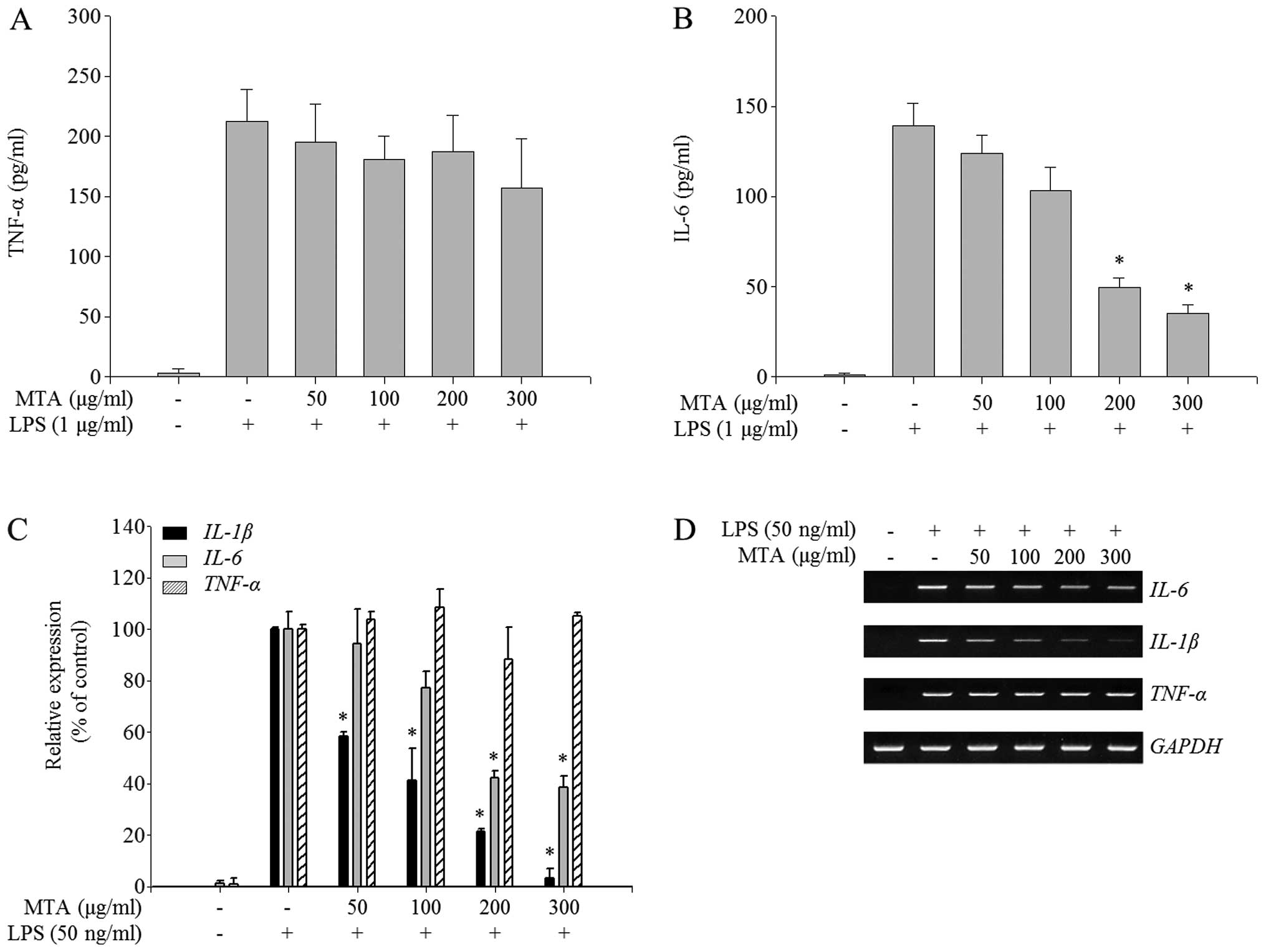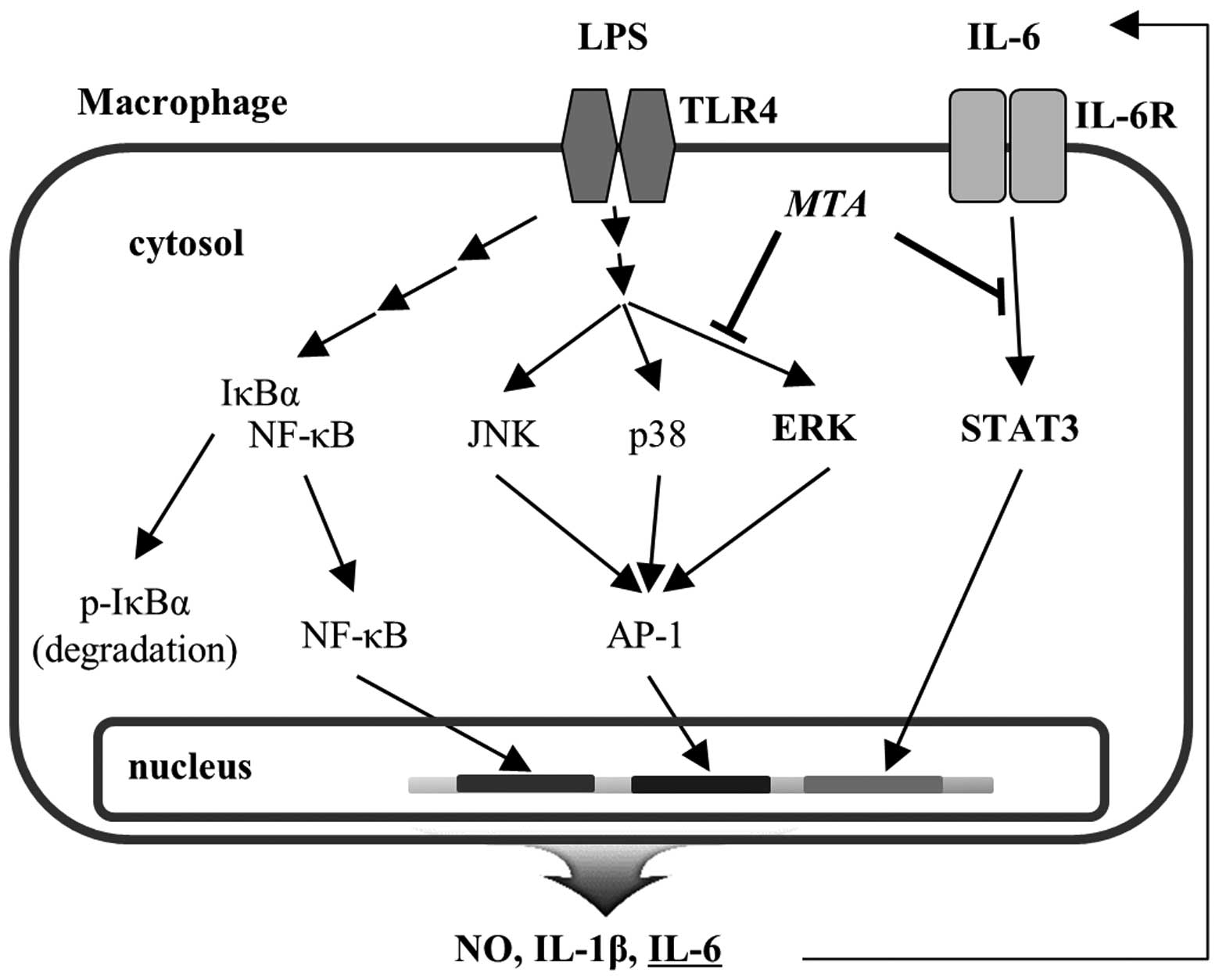|
1
|
Boscá L, Zeini M, Través PG and Hortelano
S: Nitric oxide and cell viability in inflammatory cells: a role
for NO in macrophage function and fate. Toxicology. 208:249–258.
2005. View Article : Google Scholar : PubMed/NCBI
|
|
2
|
Fujihara M, Muroi M, Tanamoto K, Suzuki T,
Azuma H and Ikeda H: Molecular mechanisms of macrophage activation
and deactivation by lipopolysaccharide: roles of the receptor
complex. Pharmacol Ther. 100:171–194. 2003. View Article : Google Scholar : PubMed/NCBI
|
|
3
|
Fujiwara N and Kobayashi K: Macrophages in
inflammation. Curr Drug Targets Inflamm Allergy. 4:281–286. 2005.
View Article : Google Scholar : PubMed/NCBI
|
|
4
|
MacMicking J, Xie QW and Nathan C: Nitric
oxide and macrophage function. Annu Rev Immunol. 15:323–350. 1997.
View Article : Google Scholar : PubMed/NCBI
|
|
5
|
Jones BW, Heldwein KA, Means TK, Saukkonen
JJ and Fenton MJ: Differential roles of Toll-like receptors in the
elicitation of proinflammatory responses by macrophages. Ann Rheum
Dis. 60(Suppl 3): iii6–iii12. 2001.
|
|
6
|
Jones BW, Means TK, Heldwein KA, Keen MA,
Hill PJ, Belisle JT and Fenton MJ: Different Toll-like receptor
agonists induce distinct macrophage responses. J Leukoc Biol.
69:1036–1044. 2001.PubMed/NCBI
|
|
7
|
Rhee SH and Hwang D: Murine Toll-like
receptor 4 confers lipopolysaccharide responsiveness as determined
by activation of NF kappa B and expression of the inducible
cyclooxygenase. J Biol Chem. 275:34035–34040. 2000. View Article : Google Scholar : PubMed/NCBI
|
|
8
|
Schroder K, Sweet MJ and Hume DA: Signal
integration between IFNgamma and TLR signalling pathways in
macrophages. Immunobiology. 211:511–524. 2006. View Article : Google Scholar : PubMed/NCBI
|
|
9
|
Stalińska K, Guzdek A, Rokicki M and Koj
A: Transcription factors as targets of the anti-inflammatory
treatment. A cell culture study with extracts from some
Mediterranean diet plants. J Physiol Pharmacol. 56(Suppl 1):
157–169. 2005.
|
|
10
|
Szabó C and Thiemermann C: Regulation of
the expression of the inducible isoform of nitric oxide synthase.
Adv Pharmacol. 34:113–153. 1995. View Article : Google Scholar : PubMed/NCBI
|
|
11
|
Clancy RM, Amin AR and Abramson SB: The
role of nitric oxide in inflammation and immunity. Arthritis Rheum.
41:1141–1151. 1998. View Article : Google Scholar : PubMed/NCBI
|
|
12
|
Guadagni F, Ferroni P, Palmirotta R,
Portarena I, Formica V and Roselli M: Review. TNF/VEGF cross-talk
in chronic inflammation-related cancer initiation and progression:
an early target in anticancer therapeutic strategy. In Vivo.
21:147–161. 2007.PubMed/NCBI
|
|
13
|
Kröncke KD, Fehsel K and Kolb-Bachofen V:
Inducible nitric oxide synthase in human diseases. Clin Exp
Immunol. 113:147–156. 1998. View Article : Google Scholar : PubMed/NCBI
|
|
14
|
Nathan C and Xie QW: Nitric oxide
synthases: roles, tolls, and controls. Cell. 78:915–918. 1994.
View Article : Google Scholar : PubMed/NCBI
|
|
15
|
Nathan C and Xie QW: Regulation of
biosynthesis of nitric oxide. J Biol Chem. 269:13725–13728.
1994.PubMed/NCBI
|
|
16
|
Nishimoto N and Kishimoto T: Interleukin
6: From bench to bedside. Nat Clin Pract Rheumatol. 2:619–626.
2006. View Article : Google Scholar : PubMed/NCBI
|
|
17
|
Hamill FA, Apio S, Mubiru NK, Mosango M,
Bukenya-Ziraba R, Maganyi OW and Soejarto DD: Traditional herbal
drugs of southern Uganda, I. J Ethnopharmacol. 70:281–300. 2000.
View Article : Google Scholar : PubMed/NCBI
|
|
18
|
Tabuti JR, Lye KA and Dhillion SS:
Traditional herbal drugs of Bulamogi, Uganda: plants, use and
administration. J Ethnopharmacol. 88:19–44. 2003. View Article : Google Scholar : PubMed/NCBI
|
|
19
|
Jeruto P, Lukhoba C, Ouma G, Otieno D and
Mutai C: An ethnobotanical study of medicinal plants used by the
Nandi people in Kenya. J Ethnopharmacol. 116:370–376. 2008.
View Article : Google Scholar : PubMed/NCBI
|
|
20
|
Okello SV, Nyunja RO, Netondo GW and
Onyango JC: Ethnobotanical study of medicinal plants used by
Sabaots of Mt. Elgon Kenya. Afr J Tradit Complement Altern Med.
7:1–10. 2009.PubMed/NCBI
|
|
21
|
Patil SB, Lende MY, Thakur VS, Naikwade NS
and Magdum CS: Sun protective activity of the hydroalchoholic
extracts of two medicinal flowers. Asian J Pharm Res. 2:37–38.
2012.
|
|
22
|
Vlietinck AJ, Van Hoof L, Totté J, Lasure
A, Vanden Berghe D, Rwangabo PC and Mvukiyumwami J: Screening of
hundred Rwandese medicinal plants for antimicrobial and antiviral
properties. J Ethnopharmacol. 46:31–47. 1995. View Article : Google Scholar : PubMed/NCBI
|
|
23
|
Jenifer S, Priya S, Laveena DK, Singh JS
and Jeyasree J: Sensitivity patterns of some flowering plants
against Salmonella typhi and Pseudomonas aeruginosa. J Pharm Pharm
Sci. 3:1212–1220. 2014.
|
|
24
|
Housti F, Andary C, Gargadennec A and
Amssa M: Effects of wounding and salicylic acid on
hydroxycinnamoylmalic acids in Thunbergia alata. Plant Physiol
Biochem. 40:761–769. 2002. View Article : Google Scholar
|
|
25
|
Damfort S, Frederiksen LB and Jensen SR:
Alatoside and thunaloside, two iridoid glucosides from Thunbergia
alata. Phytochemistry. 35:1259–1261. 1994. View Article : Google Scholar
|
|
26
|
Boegge SC, Kesper S, Verspohl EJ and
Nahrstedt A: Reduction of ACh-induced contraction of rat isolated
ileum by coptisine, (+)-caffeoylmalic acid, Chelidonium majus, and
Corydalis lutea extracts. Planta Med. 62:173–174. 1996. View Article : Google Scholar : PubMed/NCBI
|
|
27
|
Kimura Y, Okuda H, Okuda T, Hatano T and
Arichi S: Studies on the activities of tannins and related
compounds, X. Effects of caffeetannins and related compounds on
arachidonate metabolism in human polymorphonuclear leukocytes. J
Nat Prod. 50:392–399. 1987. View Article : Google Scholar : PubMed/NCBI
|
|
28
|
Pearce G, Johnson S and Ryan CA:
Purification and characterization from tobacco (Nicotiana tabacum)
leaves of six small, wound-inducible, proteinase isoinhibitors of
the potato inhibitor II family. Plant Physiol. 102:639–644. 1993.
View Article : Google Scholar : PubMed/NCBI
|
|
29
|
Cho YC, Ju A, Kim BR and Cho S:
Anti-inflammatory effects of Crataeva nurvala Buch. Ham. are
mediated via inactivation of ERK but not NF-κB. J Ethnopharmacol.
162:140–147. 2015. View Article : Google Scholar : PubMed/NCBI
|
|
30
|
Lee CW, Park SM, Kim YS, Jegal KH, Lee JR,
Cho IJ, Ku SK, Lee JY, Ahn YT, Son Y, et al: Biomolecular evidence
of anti-inflammatory effects by Clematis mandshurica Ruprecht root
extract in rodent cells. J Ethnopharmacol. 155:1141–1155. 2014.
View Article : Google Scholar : PubMed/NCBI
|
|
31
|
Yu T, Lee S, Yang WS, Jang HJ, Lee YJ, Kim
TW, Kim SY, Lee J and Cho JY: The ability of an ethanol extract of
Cinnamomum cassia to inhibit Src and spleen tyrosine kinase
activity contributes to its anti-inflammatory action. J
Ethnopharmacol. 139:566–573. 2012. View Article : Google Scholar
|
|
32
|
Lee C, Lim HK, Sakong J, Lee YS, Kim JR
and Baek SH: Janus kinase-signal transducer and activator of
transcription mediates phosphatidic acid-induced interleukin
(IL)-1beta and IL-6 production. Mol Pharmacol. 69:1041–1047.
2006.
|
|
33
|
Rubaltelli FF, Chiti G and Dani C: Adverse
effects of prenatal glucocorticoid treatment in the preterm infant.
Acta Biomed Ateneo Parmense. 68(Suppl 1): 35–38. 1997.PubMed/NCBI
|
|
34
|
Münstedt K, Borces D, Bohlmann MK, Zygmunt
M and von Georgi R: Glucocorticoid administration in antiemetic
therapy: is it safe? Cancer. 101:1696–1702. 2004. View Article : Google Scholar : PubMed/NCBI
|
|
35
|
Manelli F and Giustina A:
Glucocorticoid-induced osteoporosis. Trends Endocrinol Metab.
11:79–85. 2000. View Article : Google Scholar : PubMed/NCBI
|
|
36
|
van Raalte DH, Ouwens DM and Diamant M:
Novel insights into glucocorticoid-mediated diabetogenic effects:
towards expansion of therapeutic options? Eur J Clin Invest.
39:81–93. 2009. View Article : Google Scholar : PubMed/NCBI
|
|
37
|
Dinarello CA: Anti-inflammatory agents:
present and future. Cell. 140:935–950. 2010. View Article : Google Scholar : PubMed/NCBI
|
|
38
|
Bassett IB, Pannowitz DL and Barnetson RS:
A comparative study of tea-tree oil versus benzoylperoxide in the
treatment of acne. Med J Aust. 153:455–458. 1990.PubMed/NCBI
|
|
39
|
Naksuriya O, Okonogi S, Schiffelers RM and
Hennink WE: Curcumin nanoformulations: a review of pharmaceutical
properties and preclinical studies and clinical data related to
cancer treatment. Biomaterials. 35:3365–3383. 2014. View Article : Google Scholar : PubMed/NCBI
|
|
40
|
Ranjan AP, Mukerjee A, Helson L, Gupta R
and Vishwanatha JK: Efficacy of liposomal curcumin in a human
pancreatic tumor xenograft model: inhibition of tumor growth and
angiogenesis. Anticancer Res. 33:3603–3609. 2013.PubMed/NCBI
|
|
41
|
Burk DR, Senechal-Willis P, Lopez LC,
Hogue BG and Daskalova SM: Suppression of
lipopolysaccharide-induced inflammatory responses in RAW 264.7
murine macrophages by aqueous extract of Clinopodium vulgare L.
(Lamiaceae). J Ethnopharmacol. 126:397–405. 2009. View Article : Google Scholar : PubMed/NCBI
|
|
42
|
Liu H, Bargouti M, Zughaier S, Zheng Z,
Liu Y, Sangadala S, Boden SD and Titus L: Osteoinductive LIM
mineralization protein-1 suppresses activation of NF-kappaB and
selectively regulates MAPK pathways in pre-osteoclasts. Bone.
46:1328–1335. 2010. View Article : Google Scholar
|
|
43
|
Shan J, Fu J, Zhao Z, Kong X, Huang H, Luo
L and Yin Z: Chlorogenic acid inhibits lipopolysaccharide-induced
cyclooxygenase-2 expression in RAW264.7 cells through suppressing
NF-kappaB and JNK/AP-1 activation. Int Immunopharmacol.
9:1042–1048. 2009. View Article : Google Scholar : PubMed/NCBI
|
|
44
|
Lin CW, Hou WC, Shen SC, Juan SH, Ko CH,
Wang LM and Chen YC: Quercetin inhibition of tumor invasion via
suppressing PKC delta/ERK/AP-1-dependent matrix metalloproteinase-9
activation in breast carcinoma cells. Carcinogenesis. 29:1807–1815.
2008. View Article : Google Scholar : PubMed/NCBI
|
|
45
|
Min Z, Kang L, Lin L, Jinghua F, Junna S
and Baolin L: Resveratrol restores lysophosphatidylcholine-induced
loss of endothelium-dependent relaxation in rat aorta tissue
coinciding with inhibition of extracellular-signal-regulated
protein kinase activation. Phytother Res. 24:1762–1768. 2010.
View Article : Google Scholar : PubMed/NCBI
|
|
46
|
Wang J and Dong S: ICAM-1 and IL-8 are
expressed by DEHP and suppressed by curcumin through ERK and p38
MAPK in human umbilical vein endothelial cells. Inflammation.
35:859–870. 2012. View Article : Google Scholar
|















